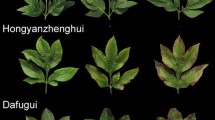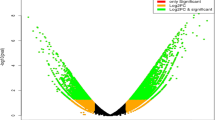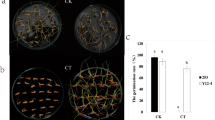Abstract
Heat stress (HS) causes detrimental effects on plant morphology, physiology, and biochemistry that lead to drastic reduction in plant biomass production and economic yield worldwide. To date, little is known about HS-responsive genes involved in thermotolerance mechanism in radish. In this study, a total of 6600 differentially expressed genes (DEGs) from the control and Heat24 cDNA libraries of radish were isolated by high-throughput sequencing. With Gene Ontology (GO) and Kyoto Encyclopedia of Genes and Genomes (KEGG) pathway analysis, some genes including MAPK, DREB, ERF, AP2, GST, Hsf, and Hsp were predominantly assigned in signal transductions, metabolic pathways, and biosynthesis and abiotic stress-responsive pathways. These pathways played significant roles in reducing stress-induced damages and enhancing heat tolerance in radish. Expression patterns of 24 candidate genes were validated by reverse-transcription quantitative PCR (RT-qPCR). Based mainly on the analysis of DEGs combining with the previous miRNAs analysis, the schematic model of HS-responsive regulatory network was proposed. To counter the effects of HS, a rapid response of the plasma membrane leads to the opening of specific calcium channels and cytoskeletal reorganization, after which HS-responsive genes are activated to repair damaged proteins and ultimately facilitate further enhancement of thermotolerance in radish. These results could provide fundamental insight into the regulatory network underlying heat tolerance in radish and facilitate further genetic manipulation of thermotolerance in root vegetable crops.







Similar content being viewed by others
Abbreviations
- HS:
-
Heat stress
- DEG:
-
Differentially expressed gene
- RNA-Seq:
-
RNA-sequencing
- RT-qPCR:
-
Reverse-transcription quantitative PCR
- KEGG:
-
Kyoto Encyclopedia of Genes and Genomes
- GO:
-
Gene ontology
- RPKM:
-
Reads per kilobase per million reads
- FDR:
-
False discovery rate
- TF:
-
Transcription factor
References
Bac-Molenaar JA, Fradin EF, Becker FF, Rienstra JA, van der Schoot J, Vreugdenhil D, Keurentjes JJ (2015) Genome-wide association mapping of fertility reduction upon heat stress reveals developmental stage-specific QTLs in Arabidopsis thaliana. Plant Cell 27(7):1857–1874. https://doi.org/10.1105/tpc.15.00248
Barnabás B, Jäger K, Fehér A (2008) The effect of drought and heat stress on reproductive processes in cereals. Plant Cell Environ 31(1):11–38. https://doi.org/10.1111/j.1365-3040.2007.01727.x
Beauchamp C, Fridovich I (1971) Superoxide dismutase: improved assays and an assay applicable to acrylamide gels. Anal Biochem 44(1):276–287. https://doi.org/10.1016/0003-2697(71)90370-8
Bedada G, Westerbergh A, Müller T, Galkin E, Bdolach E, Moshelion M, Fridman E, Schmid KJ (2014) Transcriptome sequencing of two wild barley (Hordeum spontaneum L.) ecotypes differentially adapted to drought stress reveals ecotype-specific transcripts. BMC Genomics 15(1):995. https://doi.org/10.1186/1471-2164-15-995
Belamkar V, Weeks NT, Bharti AK, Farmer AD, Graham MA, Cannon SB (2014) Comprehensive characterization and RNA-Seq profiling of the HD-Zip transcription factor family in soybean (Glycine max) during dehydration and salt stress. BMC Genomics 15(1):950. https://doi.org/10.1186/1471-2164-15-950
Bhardwaj AR, Joshi G, Kukreja B, Malik V, Arora P, Pandey R, Shukla RN, Bankar KG, Katiyar-Agarwal S, Goel S (2015) Global insights into high temperature and drought stress regulated genes by RNA-Seq in economically important oilseed crop Brassica juncea. BMC Plant Biol 15:9
Charng YY, Liu HC, Liu NY, Chi WT, Wang CN, Chang SH, Wang TT (2007) A heat-inducible transcription factor, HsfA2, is required for extension of acquired thermotolerance in Arabidopsis. Plant Physiol 143(1):251–262. https://doi.org/10.1104/pp.106.091322
Chen QS, Li M, Zhang ZC, Tie WW, Chen X, Jin LF, Zhai N, Zheng QX, Zhang JF, Wang R, GY X, Zhang H, Liu PP, Zhou H (2017) Integrated mRNA and microRNA analysis identifies genes and small miRNA molecules associated with transcriptional and post-transcriptional-level responses to both drought stress and re-watering treatment in tobacco. BMC Genomics 18(1):62. https://doi.org/10.1186/s12864-016-3372-0
Conesa A, Götz S, García-Gómez JM, Terol J, Talón M, Robles M (2005) Blast2GO: a universal tool for annotation, visualization and analysis in functional genomics research. Bioinformatics 21(18):3674–3676. https://doi.org/10.1093/bioinformatics/bti610
Czarnecka-Verner E, Yuan CX, Scharf KD, Englich C, Gurley WB (2000) Plants contain a novel multi-member class of heat shock factors without transcriptional activator potential. Plant Mol Biol 43(4):459–471. https://doi.org/10.1023/A:1006448607740
Ferdous J, Sanchez-Ferrero JC, Langridge P, Milne L, Chowdhury J, Brien C, Tricker PJ (2017) Differential expression of microRNAs and potential targets under drought stress in barley. Plant Cell Environ 40(1):11–24. https://doi.org/10.1111/pce.12764
Filippou P, Bouchagier P, Skotti E, Fotopoulos V (2014) Proline and reactive oxygen/nitrogen species metabolism is involved in the tolerant response of the invasive plant species Ailanthus altissima to drought and salinity. Environ Exp Bot 97:1–10. https://doi.org/10.1016/j.envexpbot.2013.09.010
Finkel T, Holbrook NJ (2000) Oxidants, oxidative stress and the biology of ageing. Nature 408(6809):239–247. https://doi.org/10.1038/35041687
Fracasso A, Trindade LM, Amaducci S (2016) Drought stress tolerance strategies revealed by RNA-Seq in two sorghum genotypes with contrasting WUE. BMC Plant Biol 16:115
Frank G, Pressman E, Ophir R, Althan L, Shaked R, Freedman M, Shen S, Firon N (2009) Transcriptional profiling of maturing tomato (Solanum lycopersicum L.) microspores reveals the involvement of heat shock proteins, ROS scavengers, hormones, and sugars in the heat stress response. J Exp Bot 60(13):3891–3908. https://doi.org/10.1093/jxb/erp234
Giusti L, Mica E, Bertolini E, Leonardis AM, Faccioli P, Cattivelli L, Crosatti C (2017) microRNAs differentially modulated in response to heat and drought stress in durum wheat cultivars with contrasting water use efficiency. Funct Integr Genomic 17(2-3):293–309. https://doi.org/10.1007/s10142-016-0527-7
Gulli M, Corradi M, Rampino P, Marmiroli N, Perrotta C (2007) Four members of the HSP101 gene family are differently regulated in Triticum durum Desf. FEBS Lett 581(25):4841–4849. https://doi.org/10.1016/j.febslet.2007.09.010
Gutterson N, Reuber TL (2004) Regulation of disease resistance pathways by AP2/ERF transcription factors. Curr Opin Plant Biol 7(4):465–471. https://doi.org/10.1016/j.pbi.2004.04.007
Hahn A, Bublak D, Schleiff E, Scharf KD (2011) Crosstalk between Hsp90 and Hsp70 chaperones and heat stress transcription factors in tomato. Plant Cell 23(2):741–755. https://doi.org/10.1105/tpc.110.076018
Iwakawa H, Tomari Y (2015) The functions of microRNAs: mRNA decay and translational repression. Trends Cell Biol 25(11):651–665. https://doi.org/10.1016/j.tcb.2015.07.011
Jung KH, Ko HJ, Nguyen MX, Kim SR, Ronald P, An G (2012) Genome-wide identification and analysis of early heat stress responsive genes in rice. J Plant Biol 55(6):458–468. https://doi.org/10.1007/s12374-012-0271-z
Kakumanu A, Ambavaram MM, Klumas C, Krishnan A, Batlang U, Myers E, Grene R, Pereira A (2012) Effects of drought on gene expression in maize reproductive and leaf meristem tissue revealed by RNA-Seq. Plant Physiol 160(2):846–867. https://doi.org/10.1104/pp.112.200444
Kanehisa M, Goto S, Kawashima S, Nakaya A (2002) The KEGG databases at GenomeNet. Nucleic Acids Res 30(1):42–46. https://doi.org/10.1093/nar/30.1.42
Kitashiba H, Li F, Hirakawa H, Kawanabe T, Zou Z, Hasegawa Y, Tonosaki K, Shirasawa S, Fukushima A, Yokoi S (2014) Draft sequences of the radish (Raphanus sativus L.) genome. DNA Res 21(5):481–490. https://doi.org/10.1093/dnares/dsu014
Kotak S, Larkindale J, Lee U, von Koskull-Doring P, Vierling E, Scharf KD (2007) Complexity of the heat stress response in plants. Curr Opin Plant Biol 10(3):310–316. https://doi.org/10.1016/j.pbi.2007.04.011
Kruszka K, Pacak A, Swida-Barteczka A, Nuc P, Alaba S, Wroblewska Z, Karlowski W, Jarmolowsk A, Szweykowska-Kulinska Z (2014) Transcriptionally and post-transcriptionally regulated microRNAs in heat stress response in barley. J Exp Bot 65(20):6123–6135. https://doi.org/10.1093/jxb/eru353
Kumar RR, Rai RD (2014) Can wheat beat the heat: understanding the mechanism of thermotolerance in wheat (Triticum aestivum L.) Cereal Res Commun 42(1):1–18. https://doi.org/10.1556/CRC.42.2014.1.1
Li R, Yu C, Li Y, Lam TW, Yiu SM, Kristiansen K, Wang J (2009) SOAP2: an improved ultrafast tool for short read alignment. Bioinformatics 25(15):1966–1967. https://doi.org/10.1093/bioinformatics/btp336
Li J, Liu B, Cheng F, Wang X, Aarts MG, Wu J (2014a) Expression profiling reveals functionally redundant multiple-copy genes related to zinc, iron and cadmium responses in Brassica rapa. New Phytol 203(1):182–194. https://doi.org/10.1111/nph.12803
Li PS, Yu TF, He GH, Chen M, Zhou YB, Chai SC, Xu ZS, Ma YZ (2014b) Genome-wide analysis of the Hsf family in soybean and functional identification of GmHsf-34 involvement in drought and heat stresses. BMC Genomics 15(1):1009. https://doi.org/10.1186/1471-2164-15-1009
Li S, Liu J, Liu Z, Li X, Wu F, He Y (2014c) HEAT-INDUCED TAS1 TARGET1 mediates thermotolerance via HEAT STRESS TRANSCRIPTION FACTOR A1a-directed pathways in Arabidopsis. Plant Cell 26(4):1764–1780. https://doi.org/10.1105/tpc.114.124883
Li S, Fan C, Li Y, Zhang J, Sun J, Chen Y, Tian C, Su X, Lu M, Liang C, Hu Z (2016) Effects of drought and salt-stresses on gene expression in Caragana korshinskii seedlings revealed by RNA-seq. BMC Genom 17:200
Li H, Hu T, Amombo E, Fu J (2017) Genome-wide identification of heat stress-responsive small RNAs in tall fescue (Festuca arundinacea) by high-throughput sequencing. J Plant Physiol 213:157–165. https://doi.org/10.1016/j.jplph.2017.03.004
Lin YH, Huang LF, Hase T, Huang HE, Feng TY (2014) Expression of plant ferredoxin-like protein (PFLP) enhances tolerance to heat stress in Arabidopsis thaliana. New Biotechnol 32:235–242
Liu HT, Sun DY, Zhou RG (2005) Ca2+and AtCaM3 are involved in the expression of heat shock protein gene in Arabidopsis. Plant Cell Environ 28(10):1276–1284. https://doi.org/10.1111/j.1365-3040.2005.01365.x
Liu J, Zhang C, Wei C, Liu X, Wang M, Yu F, Xie Q, Tu J (2016) The RING finger ubiquitin E3 ligase OsHTAS enhances heat tolerance by promoting H2O2-induced stomatal closure in rice. Plant Physiol 170(1):429–443. https://doi.org/10.1104/pp.15.00879
Livak KJ, Schmittgen TD (2001) Analysis of relative gene expression data using real-time quantitative PCR and the 2−ΔΔCT method. Methods 25(4):402–408. https://doi.org/10.1006/meth.2001.1262
Lobell DB, Schlenker W, Costa-Roberts J (2011) Climate trends and global crop production since 1980. Science 333(6042):616–620. https://doi.org/10.1126/science.1204531
Meloni DA, Oliva MA, Martinez CA, Cambraia J (2003) Photosynthesis and activity of superoxide dismutase, peroxidase and glutathione reductase in cotton under salt stress. Environ Exp Bot 49(1):69–76. https://doi.org/10.1016/S0098-8472(02)00058-8
Mickelbart MV, Hasegawa PM, Bailey-Serres J (2015) Genetic mechanisms of abiotic stress tolerance that translate to crop yield stability. Nat Rev Genet 16(4):237–251. https://doi.org/10.1038/nrg3901
Mittler R, Finka A, Goloubinoff P (2012) How do plants feel the heat? Trends Biochem Sci 37(3):118–125. https://doi.org/10.1016/j.tibs.2011.11.007
Nagalakshmi U, Wang Z, Waern K, Shou C, Raha D, Gerstein M, Snyder M (2008) The transcriptional landscape of the yeast genome defined by RNA sequencing. Science 320(5881):1344–1349. https://doi.org/10.1126/science.1158441
Ohama N, Sato H, Shinozaki K, Yamaguchi-Shinozaki K (2017) Transcriptional regulatory network of plant heat stress response. Trends Plant Sci 22(1):53–65
Ouyang Y, Chen J, Xie W, Wang L, Zhang Q (2009) Comprehensive sequence and expression profile analysis of Hsp20 gene family in rice. Plant Mol Biol 70(3):341–357. https://doi.org/10.1007/s11103-009-9477-y
Pandey B, Kaur A, Gupta OP, Sharma I, Sharma P (2015) Identification of HSP20 gene family in wheat and barley and their differential expression profiling under heat stress. Appl Biochem Biotechnol 175(5):2427–2446. https://doi.org/10.1007/s12010-014-1420-2
Qin F, Kakimoto M, Sakuma Y, Maruyama K, Osakabe Y, Tran LSP, Shinozaki K, Yamaguchi-Shinozaki K (2007) Regulation and functional analysis of ZmDREB2A, in response to drought and heat stresses in Zea mays L. Plant J 50(1):54–69. https://doi.org/10.1111/j.1365-313X.2007.03034.x
Qu AL, Ding YF, Jiang Q, Zhu C (2013) Molecular mechanisms of the plant heat stress response. Biochem Biophys Res Commun 432(2):203–207. https://doi.org/10.1016/j.bbrc.2013.01.104
Saidi Y, Finka A, Goloubinoff P (2011) Heat perception and signalling in plants: a tortuous path to thermotolerance. New Phytol 190(3):556–565. https://doi.org/10.1111/j.1469-8137.2010.03571.x
Sanchez DH, Paszkowski J (2014) Heat-induced release of epigenetic silencing reveals the concealed role of an imprinted plant gene. PLoS Genet 10(11):e1004806. https://doi.org/10.1371/journal.pgen.1004806
Schramm F, Larkindale J, Kiehlmann E, Ganguli A, Englich G, Vierling E, Koskull-Döring V (2008) A cascade of transcription factor DREB2A and heat stress transcription factor HsfA3 regulates the heat stress response of Arabidopsis. Plant J 53(2):264–274. https://doi.org/10.1111/j.1365-313X.2007.03334.x
Song X, Li Y, Hou X (2013) Genome-wide analysis of the AP2/ERF transcription factor superfamily in Chinese cabbage(Brassica rapa ssp. pekinensis). BMC Genomics 14(1):573. https://doi.org/10.1186/1471-2164-14-573
Sun J, Ren L, Cheng Y, Gao J, Dong B, Chen S, Chen F, Jiang J (2014) Identification of differentially expressed genes in Chrysanthemum nankingense (Asteraceae) under heat stress by RNA Seq. Gene 552(1):59–66. https://doi.org/10.1016/j.gene.2014.09.013
Tan GF, Wang F, Li MY, Wang GL, Jiang Q, Xiong AS (2015) De novo assembly and transcriptome characterization: novel insights into the temperature stress in Cryptotaenia japonica Hassk. Acta Physiol Plant 37:1739
Tarazona S, García-Alcalde F, Dopazo J, Ferrer A, Conesa A (2011) Differential expression in RNA-seq: a matter of depth. Genome Res 21(12):2213–2223. https://doi.org/10.1101/gr.124321.111
von Koskull-Doring P, Scharf KD, Nover L (2007) The diversity of plant heat stress transcription factors. Trends Plant Sci 12(10):452–457. https://doi.org/10.1016/j.tplants.2007.08.014
Wahid A, Gelani S, Ashraf M, Foolad M (2007) Heat tolerance in plants: an overview. Environ Exp Bot 61(3):199–223. https://doi.org/10.1016/j.envexpbot.2007.05.011
Wang KL-C, Li H, Ecker JR (2002) Ethylene biosynthesis and signaling network. Plant Cell 14(suppl 1):S131–S151. https://doi.org/10.1105/tpc.001768
Wang Z, Gerstein M, Snyder M (2009) RNA-Seq: a revolutionary tool for transcriptomics. Nat Rev Genet 10(1):57–63. https://doi.org/10.1038/nrg2484
Wang Y, Xu L, Chen Y, Shen H, Gong Y, Limera C, Liu L (2013) Transcriptome profiling of radish (Raphanus sativus L.) root and identification of genes involved in response to lead (Pb) stress with next generation sequencing. PLoS One 8(6):e66539. https://doi.org/10.1371/journal.pone.0066539
Wang J, Wang Q, Yang Y, Liu X, Gu J, Li W, Ma S, Lu Y (2014) De novo assembly and characterization of stress transcriptome and regulatory network under temperature, salt and hormone stresses in Lilium lancifolium. Mol Biol Rep 41(12):8231–8245. https://doi.org/10.1007/s11033-014-3725-1
Wang R, Xu L, Zhu X, Zhai L, Wang Y, Yu R, Gong Y, Limera C, Liu L (2015) Transcriptome-wide characterization of novel and heat-stress-responsive microRNAs in radish (Raphanus sativus L.) using next-generation sequencing. Plant Mol Biol Report 33(4):867–880. https://doi.org/10.1007/s11105-014-0786-1
Xie C, Mao X, Huang J, Ding Y, Wu J, Dong S, Kong L, Gao G, Li CY, Wei L (2011) KOBAS 2.0: a web server for annotation and identification of enriched pathways and diseases. Nucleic Acids Res 39(suppl_2):W316–W322. https://doi.org/10.1093/nar/gkr483
Xie Y, Ye S, Wang Y, Xu L, Zhu X, Yang J, Feng H, Yu R, Karanja B, Gong Y (2015) Transcriptome-based gene profiling provides novel insights into the characteristics of radish root response to Cr stress with next-generation sequencing. Front Plant Sci 6:202
Xu ZZ, Zhou GS (2006) Combined effects of water stress and high temperature on photosynthesis, nitrogen metabolism and lipid peroxidation of a perennial grass Leymus chinensis. Planta 224(5):1080–1090
Xu S, Li J, Zhang X, Wei H, Cui L (2006) Effects of heat acclimation pretreatment on changes of membrane lipid peroxidation, antioxidant metabolites, and ultrastructure of chloroplasts in two cool-season turfgrass species under heat stress. Environ Exp Bot 56(3):274–285. https://doi.org/10.1016/j.envexpbot.2005.03.002
Xu J, Duan X, Yang J, Beeching JR, Zhang P (2013) Enhanced reactive oxygen species scavenging byoverproduction of superoxide dismutase and catalase delays postharvest physiological deterioration of cassava storage roots. Plant Physiol 161(3):1517–1528. https://doi.org/10.1104/pp.112.212803
Xu J, Yang J, Duan X, Jiang Y, Zhang P (2014) Increased expression of native cytosolic Cu/Zn superoxide dismutase and ascorbate peroxidase improves tolerance to oxidative and chilling stresses in cassava (Manihot esculenta Crantz). BMC Plant Biol 14(1):208. https://doi.org/10.1186/s12870-014-0208-4
Xu L, Wang Y, Liu W, Wang J, Zhu X, Zhang K, Yu R, Wang R, Xie Y, Zhang W (2015) De novo sequencing of root transcriptome reveals complex cadmium-responsive regulatory network in radish (Raphanus sativus L). Plant Sci 236:313–323. https://doi.org/10.1016/j.plantsci.2015.04.015
Ye J, Fang L, Zheng H, Zhang Y, Chen J, Zhang Z, Wang J, Li S, Li R, Bolund L, Wang J (2006) WEGO: a web tool for plotting GO annotations. Nucleic Acids Res 34(Web Server):W293–W297. https://doi.org/10.1093/nar/gkl031
Zeller G, Henz SR, Widmer CK, Sachsenberg T, Rätsch G, Weigel D, Laubinger S (2009) Stress-induced changes in the Arabidopsis thaliana transcriptome analyzed using whole-genome tiling arrays. Plant J 58(6):1068–1082. https://doi.org/10.1111/j.1365-313X.2009.03835.x
Zhang B (2015) MicroRNA: a new target for improving plant tolerance to abiotic stress. J Exp Bot 66(7):1749–1761. https://doi.org/10.1093/jxb/erv013
Zhang M, Liu X, Yuan L, Wu K, Duan J, Wang X, Yang L (2012) Transcriptional profiling in cadmium-treated rice seedling roots using suppressive subtractive hybridization. Plant Physiol Biochem 50(1):79–86. https://doi.org/10.1016/j.plaphy.2011.07.015
Zhang XN, Li X, Liu JH (2013a) Identification of conserved and novel cold-responsive microRNAs in Trifoliate orange (Poncirus trifoliata (L.) Raf.) using high-throughput sequencing. Plant Mol Biol Report 32(2):328–341
Zhang Y, Xu L, Zhu X, Gong Y, Xiang F, Sun X, Liu L (2013b) Proteomic analysis of heat stress response in leaves of radish (Raphanus sativus L.) Plant Mol Biol Report 31(1):195–203. https://doi.org/10.1007/s11105-012-0486-7
Acknowledgments
This work was in part supported by grants from the National Key Technology Research and Development Program of China (2016YFD0100204-25), Jiangsu Agricultural Science and Technology Innovation Fund (JASTIF, CX(13)5082), and the Key Technology Research and Development Program of Jiangsu Province (BE2016379).
Author information
Authors and Affiliations
Contributions
RW and LL designed the experiments and drafted the manuscript. RW and YM planted radish seedlings, collected tissues, and prepared the mRNA library for Solexa sequencing. LX and JG participated in the design of the study. YM and YW performed the statistical analysis. XZ and LL reviewed and revised the manuscript. All authors read and approved the final manuscript.
Corresponding author
Ethics declarations
Conflict of interest
The authors declare that they have no conflict of interest.
Electronic supplementary material
Supplementary Table 1
(XLS 27 kb).
Supplementary Table 2
(XLS 2638 kb).
Supplementary Table 3
(XLS 205 kb).
Supplementary Table 4
(XLS 64 kb).
Supplementary Table 5
(XLS 88 kb).
Supplementary Table 6
(XLS 35 kb).
Supplementary Table 7
(XLS 96 kb).
Rights and permissions
About this article
Cite this article
Wang, R., Mei, Y., Xu, L. et al. Genome-wide characterization of differentially expressed genes provides insights into regulatory network of heat stress response in radish (Raphanus sativus L.). Funct Integr Genomics 18, 225–239 (2018). https://doi.org/10.1007/s10142-017-0587-3
Received:
Revised:
Accepted:
Published:
Issue Date:
DOI: https://doi.org/10.1007/s10142-017-0587-3




